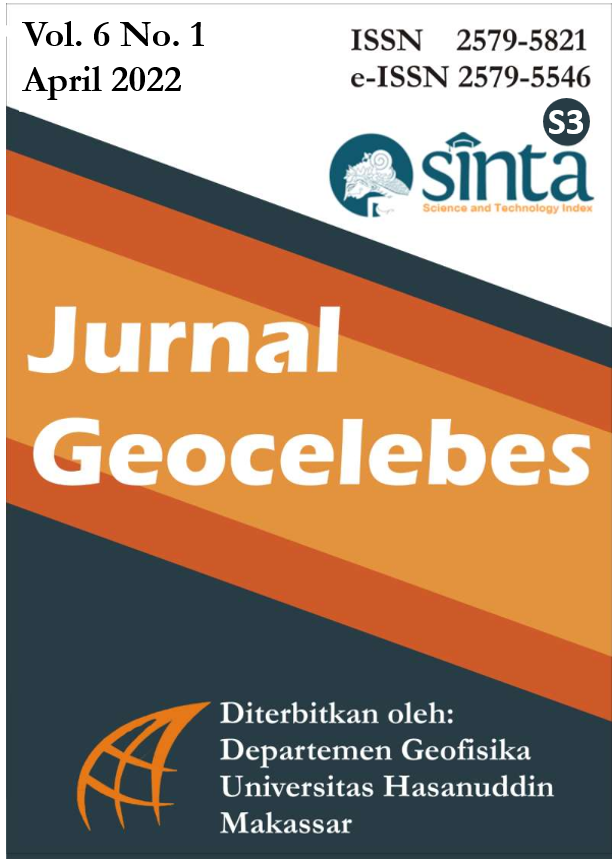Geology and Potential Flash Flood Vulnerability of Sungai Jernih Village and Surroundings, Pondok Tinggi District, Kerinci Regency, Jambi
Geologi dan Potensi Kerawanan Banjir Bandang Desa Sungai Jernih dan Sekitarnya, Kecamatan Pondok Tinggi, Kabupaten Kerinci, Jambi
DOI:
https://doi.org/10.20956/geocelebes.v6i1.14824Keywords:
flash flood, overlay, scoring, Sungai JernihAbstract
Sungai Jernih Village and its surroundings have relatively steep slopes. Based on rainfall data for the last three years this area has moderate rainfall, with a tropical climate. In general, making the weathering level around it high and causing weathered soil/rock material conditions so that it is not strong retain the volume of water that is absorbed by the surface. The weathering can be carried away by water currents and flash floods. Pondok Tinggi sub-district has experienced flash floods, one of which was on May 13, 2017. The method used in this study is a direct mapping method, namely conducting field observations to map the distribution of lithology. Prior to field observations, analysis of secondary data obtained from literature studies and other sources was carried out to consider the results of field observations as a basic reference for research. Mapping results in the form of maps and parameter analysis using scoring overlaid with ArcGIS software. The low level of vulnerability with an area of 51.25% consists of 2 sub-districts, are in Pondok Tinggi District and Kumun District. The level of vulnerability is sufficient with an area of 25.39% consisting of 2 sub-districts are Sungai Bungkal District and Pondok Tinggi District. Then the highest vulnerability level with an area of 23.36% consists of 4 districts are Pesisir Bukit District, Sungai Bungkal District, Sungai Bungkal District Full and Pondok Tinggi District.
References
Adi, S. 2013. Karakteristik Bencana Banjir Bandang di Indonesia di Indonesia. Jurnal Sains dan Teknologi Indoesia. 15(1), pp.42-51. https://dx.doi.org/10.29122/jsti.v15i1.938
Barber, A.J., Crow, M.J. and Milsom, J.S. 2005. Sumatera: Geology, Resources and Tectonic Evolution. Geological Society of London. https://doi.org/10.1144/GSL.MEM.2005.031
Carolin, C.B., Suhendra, S. and Dony, W. 2021. Penentuan Klasifikasi Tanah Sistem Uscs (Unified Soil Classification System) dengan Bantuan Ms Excel. Jurnal Civronlit. 6(2), pp.76-84. http://dx.doi.org/10.33087/civronlit.v6i2.88
Peraturan Kepala Badan Nasional Penanggulangan Bencana No. 02 Tahun 2012. Tentang Pedoman Umum Pengkajian Risiko Bencana. https://bnpb.go.id/produk-hukum/peraturan-kepala-bnpb/peraturan-kepala-bnpb-no-02-tahun-2012
Howard, A.D. 1967. Drainage Analysis in Geologic Interpretation: A Summation. AAPG Bulletin. 51(11), pp.2246–2259. https://doi.org/10.1306/5D25C26D-16C1-11D7-8645000102C1865D
Peraturan Menteri Kehutanan Republik Indonesia No. P.32/MENHUT-II/2009 Tentang Tata Cara Penyusunan Rencana Teknik Rehabilitasi Hutan Dan Lahan Daerah Aliran Sungai (RTkRHL-DAS). https://jdih.mkri.id/mg58ufsc89hrsg/P32_09.pdf
Poedjopradjitno, S. 2012. Morfotektonik dan Potensi Bencana Alam di Lembah Kerinci Sumatera Barat, Berdasarkan Analisis Potret Udara. Jurnal Geologi dan Sumberdaya Mineral. 22(2), pp.101-110 https://jgsm.geologi.esdm.go.id/index.php/JGSM/article/view/110
Schmidt, F.H. and Fergusson, J.H.A. 1951. Rainfall Type Based on Wet and Dry Period Ratios for Indonesia with Western New Guinea. Jakarta: Kementerian Perhubungan RI, Djawatan Meteorologi dan Geofisik
Sudijono, A. 2007. Pengantar Evaluasi Pendidikan. Jakarta: Raja Grafindo Persada.
Suhardiman, 2012. Zonasi Tingkat Kerawanan Banjir dengan Sistem Informasi Geografis (SIG) Pada Sub DAS Walanae Hilir. Bachelor thesis, Universitas Hasanudin.
Utama, L. and Naumar, A. 2015. Kajian Kerentanan Kawasan Berpotensi Banjir Bandang dan Mitigasi Bencna pada Daerah Aliran Sungai (DAS) Batang Kuranji Kota Padang. Jurnal Rekayasa Sipil. 9(1), pp.21-28. https://rekayasasipil.ub.ac.id/index.php/rs/article/view/294
van Bemmelen, R.W. 1949. The Geology of Indonesia Vol 1A. Martinuss Nyoff: The Hauge.
Versteppen, H. 1973. A geomorphological reconnaisaance of Soematra and adjacent island (Indonesia). Netherlands: ITC.
Downloads
Published
How to Cite
Issue
Section
License
Authors who publish with this journal agree to the following terms:
- Authors retain copyright and grant the journal right of first publication with the work simultaneously licensed under a Creative Commons Attribution License that allows others to share the work with an acknowledgement of the work's authorship and initial publication in this journal.
- Authors are able to enter into separate, additional contractual arrangements for the non-exclusive distribution of the journal's published version of the work (e.g., post it to an institutional repository or publish it in a book), with an acknowledgement of its initial publication in this journal.
- Authors are permitted and encouraged to post their work online (e.g., in institutional repositories or on their website) prior to and during the submission process, as it can lead to productive exchanges, as well as earlier and greater citation of published work (See The Effect of Open Access).





